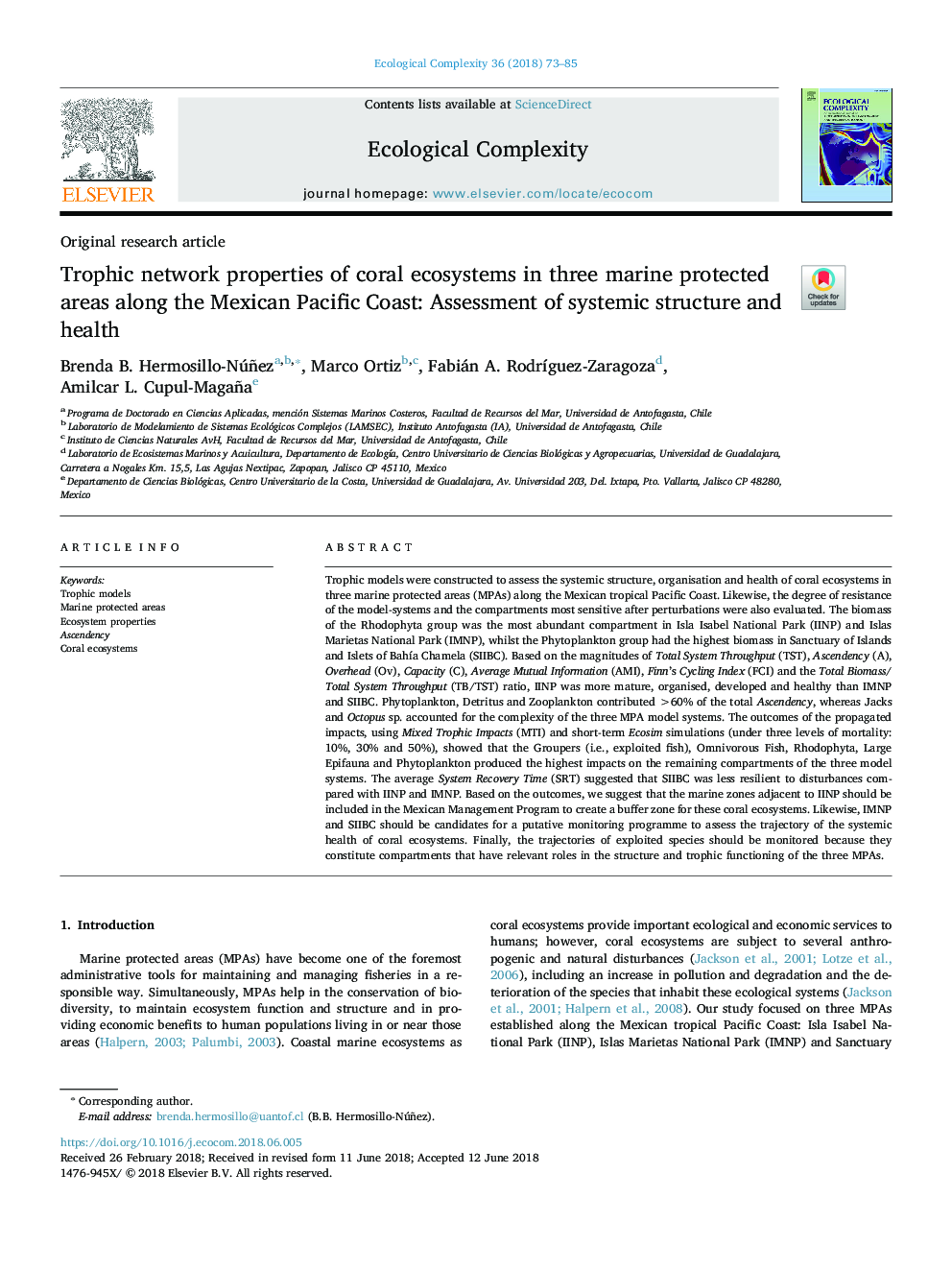| کد مقاله | کد نشریه | سال انتشار | مقاله انگلیسی | نسخه تمام متن |
|---|---|---|---|---|
| 8844800 | 1617078 | 2018 | 13 صفحه PDF | دانلود رایگان |
عنوان انگلیسی مقاله ISI
Trophic network properties of coral ecosystems in three marine protected areas along the Mexican Pacific Coast: Assessment of systemic structure and health
ترجمه فارسی عنوان
خصوصیات شبکه های طوفان اکوسیستم های مرجانی در سه ناحیه حفاظت شده دریایی در ساحل اقیانوس آرام مکزیک: ارزیابی ساختار سیستمیک و سلامت
دانلود مقاله + سفارش ترجمه
دانلود مقاله ISI انگلیسی
رایگان برای ایرانیان
کلمات کلیدی
مدل های تروفی مناطق حفاظت شده دریایی، خواص اکوسیستم، صعود، اکوسیستم مرجانی،
موضوعات مرتبط
علوم زیستی و بیوفناوری
علوم کشاورزی و بیولوژیک
بوم شناسی، تکامل، رفتار و سامانه شناسی
چکیده انگلیسی
Trophic models were constructed to assess the systemic structure, organisation and health of coral ecosystems in three marine protected areas (MPAs) along the Mexican tropical Pacific Coast. Likewise, the degree of resistance of the model-systems and the compartments most sensitive after perturbations were also evaluated. The biomass of the Rhodophyta group was the most abundant compartment in Isla Isabel National Park (IINP) and Islas Marietas National Park (IMNP), whilst the Phytoplankton group had the highest biomass in Sanctuary of Islands and Islets of BahÃa Chamela (SIIBC). Based on the magnitudes of Total System Throughput (TST), Ascendency (A), Overhead (Ov), Capacity (C), Average Mutual Information (AMI), Finn's Cycling Index (FCI) and the Total Biomass/Total System Throughput (TB/TST) ratio, IINP was more mature, organised, developed and healthy than IMNP and SIIBC. Phytoplankton, Detritus and Zooplankton contributed >60% of the total Ascendency, whereas Jacks and Octopus sp. accounted for the complexity of the three MPA model systems. The outcomes of the propagated impacts, using Mixed Trophic Impacts (MTI) and short-term Ecosim simulations (under three levels of mortality: 10%, 30% and 50%), showed that the Groupers (i.e., exploited fish), Omnivorous Fish, Rhodophyta, Large Epifauna and Phytoplankton produced the highest impacts on the remaining compartments of the three model systems. The average System Recovery Time (SRT) suggested that SIIBC was less resilient to disturbances compared with IINP and IMNP. Based on the outcomes, we suggest that the marine zones adjacent to IINP should be included in the Mexican Management Program to create a buffer zone for these coral ecosystems. Likewise, IMNP and SIIBC should be candidates for a putative monitoring programme to assess the trajectory of the systemic health of coral ecosystems. Finally, the trajectories of exploited species should be monitored because they constitute compartments that have relevant roles in the structure and trophic functioning of the three MPAs.
ناشر
Database: Elsevier - ScienceDirect (ساینس دایرکت)
Journal: Ecological Complexity - Volume 36, December 2018, Pages 73-85
Journal: Ecological Complexity - Volume 36, December 2018, Pages 73-85
نویسندگان
Brenda B. Hermosillo-Núñez, Marco Ortiz, Fabián A. RodrÃguez-Zaragoza, Amilcar L. Cupul-Magaña,
